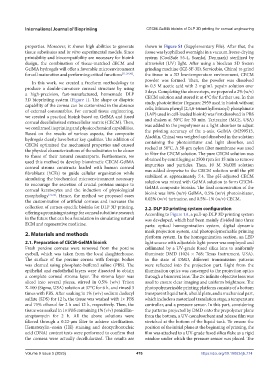Page 484 - IJB-9-5
P. 484
International Journal of Bioprinting CECM-GelMA bioinks of DLP 3D printing for corneal engineering
properties. Moreover, it shows high abilities to generate shown in Figure S1 (Supplementary File). After that, the
tissue substitutes and in vitro experimental models. Since tissue was lyophilized overnight in a vacuum freeze-drying
printability and biocompatibility are necessary for bioink system (CoolSafe 55-4, Scanlaf, Denmark) sterilized by
design, the combination of tissue-matched dECM and ultraviolet (UV) light. After using a bioclean 3D frozen
GelMA hydrogels will offer a favorable microenvironment grinding machine (KZ-5F-3D, Servicebio, China) to grind
for cell maturation and performing critical functions [11,29,30] . the tissue in a 3D low-temperature environment, CECM
In this work, we created a freeform methodology to powder was formed. Then, the powder was dissolved
produce a double-curvature corneal structure by using in 0.5 M acetic acid with 2 mg/mL pepsin solution over
a high-precision, fast-manufactured, homemade DLP 3 days. Completing the above steps, we prepared a 2% (w/v)
3D bioprinting system (Figure 1). The shape or dioptric CECM solution and stored it at 4°C for further use. In this
capability of the cornea can be customized in the absence study, photoinitiator (Irgacure 2959 used in bioink without
of external consumables. For corneal tissue engineering, cells; lithium phenyl (2,4,6-trimethylbenzoyl) phosphinate
we created a practical bioink based on GelMA and fused (LAP) used in cell-loaded bioink) was first dissolved in PBS
corneal decellularized extracellular matrix (CECM). Then, and shaken at 50°C for 30 min. Tartrazine (MCE, USA)
we confirmed its printing and physicochemical capabilities. was added to the prepolymer as a light absorber to adjust
Based on the results of various aspects, the composite the printing accuracy of the z-axis. GelMA (M299513,
hydrogels clearly have better key qualities. The addition of Aladdin, China) was weighed and dissolved in the solution
CECM optimized the mechanical properties and caused containing the photoinitiator and light absorber, and
the physical characterizations of the substitutes to be closer rocked at 50°C. A 50-μm nylon filter membrane was used
to those of their natural counterparts. Furthermore, we to filter the CECM solution. The pure CECM solution was
used this method to develop biomimetic CECM-GelMA obtained by centrifuging at 2500 rpm for 15 min to remove
corneal stroma constructs loaded with human corneal impurities and particles. Then, 10 M NaOH solution
fibroblasts (hCFs) to guide cellular organization while was added dropwise to the CECM solution until the pH
simulating the biochemical microenvironment necessary stabilized at approximately 7.4. The pH-adjusted CECM
to encourage the secretion of crucial proteins unique to solution was mixed with GelMA solution to form CECM-
corneal keratocytes and the induction of physiological GelMA composite bioinks. The final concentration of the
morphology [31,32] . Hence, the method we proposed eases bioink was 10% (w/v) GelMA, 0.5% (w/v) photoinitiator,
the customization of artificial corneas and increases the 0.02% (w/v) tartrazine, and 0.5%–1% (w/v) CECM.
collection of cornea-specific bioinks for DLP 3D printing, 2.2. DLP 3D printing system configuration
offering a promising strategy for corneal substitute research According to Figure 1A, a pull-up DLP 3D printing system
in the future that can be a foundation in simulating natural was developed, which had been mainly divided into three
ECM and regenerative medicine. parts: optical homogenization system, digital dynamic
2. Materials and methods mask projection system, and photopolymerizable printing
platform system. In the homogenization section, an LED
2.1. Preparation of CECM-GelMA bioink light source with adjustable light power was employed and
Fresh porcine corneas were removed from the porcine collimated by a UV-grade fused silica lens to uniformly
eyeball, which was taken from the local slaughterhouse. illuminate DMD (1024 × 768; Texas Instrument, USA).
The surface of the porcine cornea with foreign bodies In the state of DMD, different transmission patterns
was cleaned using phosphate-buffered saline (PBS). The were reflected into the projection part. Light from the
epithelial and endothelial layers were dissected to obtain illumination optics was converged to the projection optics
a complete corneal stroma layer. The stroma layer was through a biconvex lens. The 2× infinite objective lens was
sliced into several pieces, stirred in 0.5% (w/v) Triton used to ensure clear imaging and uniform brightness. The
X-100 (Sigma, USA) solution at 37°C for 6 h, and rinsed 3 photopolymerizable printing platform consists of a bottom
times with PBS. After soaking in 1% (w/v) sodium dodecyl transparent liquid tank, a build plate, and a mechanical part,
sulfate (SDS) for 12 h, the tissue was washed with 1× PBS which includes a motorized translation stage, a temperature
and 75% ethanol for 2 h and 12 h, respectively. Then, the controller, and a pressure sensor. In this part, considering
tissue was soaked in 1× PBS containing 1% (v/v) penicillin– the patterns projected by DMD onto the prepolymer plane
streptomycin for 2 h. All the above solutions were from the bottom, a UV-nonabsorbent and release film was
filtered through a 0.22-μm filter to achieve sterilization. stretched at the bottom of the liquid tank. To ensure the
Hematoxylin–eosin (HE) staining and deoxyribonucleic position of the initial plane at the beginning of printing, the
acid (DNA) content tests were performed to confirm that film was attached to a UV-grade fused silica flake as a rigid
the corneas were actually decellularized. The results are window under which the pressure sensor was placed. The
Volume 9 Issue 5 (2023) 476 https://doi.org/10.18063/ijb.774

